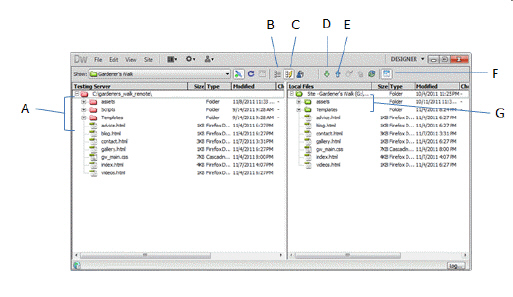Which of the following are types of service agreements.
What will be an ideal response?
a. Memorandum of understanding (MOU)
b. service level agreement (SLA)
c. master service agreement (MSA)
d. statement of work (SOW)
e. acceptable use policy (AUP)
You might also like to view...
 Item A shows which of the following of Dreamweaver's built-in ftp client?
Item A shows which of the following of Dreamweaver's built-in ftp client?
A. Local folders B. Testing server folders C. Save folders D. Image folders
?Which of the following is true of transformations in three dimensions?
A. ?Positive values along the axes are to the right, down, and away from a reader. B. ?Positive values along the axes are to the left, up, and away from a reader. C. ?Negative values along the axes are to the right, down, and toward a reader. D. ?Negative values along the axes are to the left, up, and away from a reader.
To test whether values are within or outside of the specified range use the ____________________ instruction.
Fill in the blank(s) with the appropriate word(s).
?Match each correct item with the statement below.
A. A number indicating a protocol's reliability, with lower values being given higher priority. This assignment can be changed by a network administrator when one protocol should take precedence over a previously higher-rated protocol on a network.? B. A globally unique number that identifies an autonomous system. ASNs work similarly to IP addresses that identify individual nodes on a network. Each ASN now consists of 32 bits instead of 16 bits, and they are assigned by IANA.? C. The router on a network that accepts all unroutable messages from other routers.? D. ?A router that connects an autonomous system with an outside network-for example, the router that connects a business to its ISP. E. A router that directs data between networks within the same autonomous system.? F. ?The delay between the transmission of a signal and its receipt. G. The largest IP packet size in bytes allowable by routers in a path without fragmentation and excluding the frame size.? H. A process whereby routers learn about all of the devices on their networks. On IPv4 networks, this process is managed by ARP with help from ICMP. On IPv6 networks, NDP (Neighbor Discovery Protocol) automatically detects neighboring devices and automatically adjusts when nodes fail or are removed from the network.? I. ?A repeated trial message transmitted by the tracert and traceroute utilities to trigger routers along a route to return specific information about the route. J. ?Properties of a route used by routing protocols to determine the best path to a destination when various paths are available. Routing metrics may be calculated using any of several variables, including hop count, bandwidth, delay, MTU, cost, and reliability.